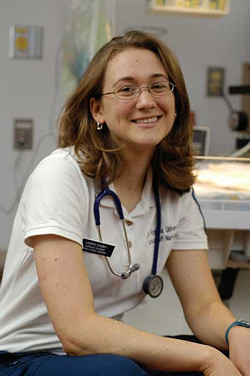Bienvenido, Bebecito!! Welcome to the World.
By Lauren Shimek ’09
On a cold Thursday morning in March, a warm squirming bundle taught Lauren Shimek ’09 what it means to be a nurse. This birth was the first that she attended as part of her clinical rotation on the Obstetrics and Gynecology unit at the Johns Hopkins Bayview Medical Center.
8:00 a.m. A 19-year-old Hispanic woman comes into the unit for a scheduled c-section. She speaks no English. With a few years of undergraduate Spanish and a recent medical terminology course under my belt, she’s designated to be my patient for the day.
8:30 a.m. As a translator, I help the nurse complete the assessment information and prepare the patient for the operating room.
9:00 a.m. I orient her husband to the recovery room, assist him in gowning up for the operating room, and explain what will happen during the procedure.
9:30 a.m. My patient and I are in the OR with the scrub nurse, resident and attending anesthesiologist, and resident and attending surgeon. As my patient receives her epidural, the attending anesthesiologist explains to me step-by-step what the resident will do to administer the pain medication. I help to translate this process to my patient.
9:45 a.m. I gown myself in sterile scrubs and gloves to assist in the operation with the surgeon and resident. Elbow to elbow with the surgeon, she explains to me the process of the cesarean. Layer by layer, my patient is sliced open. Upon reaching the uterus, one last precise incision is made and the bag of water ruptures. My gown is soaked in amniotic fluid; my hands and wrists are covered in blood.
10:04 a.m. The attending pulls out a 38-week-old baby boy. My hands catch part of the baby and cradle him as the umbilical cord is cut. The attending surgeon pulls the uterus out of the woman’s abdomen while cleansing the patient’s inner cavity. She points out to me the ovaries and the fallopian tubes. I help the attending and resident by retracting the initial incision’s edges while my patient’s uterus is sewn back together and returned to the abdomen.
10:45 a.m. My patient is stitched up, her baby is in a bassinet nearby undergoing initial assessments, and the surgeons are leaving the OR. I speak with my patient about her delivery, ask her how she is feeling, and reenact the sensation of catching her baby from the uterus and describe how beautiful his little face was.
11:15 a.m. In the recovery room, I assess the vital signs of my new mom, put a warm blanket on her, and explain to her how to use her patient-controlled anesthesia pump.
11:30 a.m. I wrap up her new baby in a warm blanket, bring him to her chest, and we both admire his soft features and tiny body. He sucks on my finger.
11:45 a.m. A lesson in breast feeding-my new mom has never breast fed. I teach her how to cradle his head against her chest, listen for the sounds to assure that he is suckling, and explain the importance of her own milk during the first few hours of the child’s life.
12:00 a.m. I recognize the phenomenal opportunity that I have as a nurse to support my patient. I was at her side from the moment she walked in the door to the unit until that priceless moment when her baby suckled from her breast for the first time. For a 19-year-old woman, these moments are scary, anxiety provoking, and extremely personal. As a nursing student and her advocate, I educated and comforted my patient while simultaneously acting as her voice and translator.
Why did I choose nursing? For priceless experiences like these: using the Spanish language to coach a fearful young patient through the process of receiving an epidural and catheter; the opportunity to teach her the process of breast feeding; and the ability to sooth this new mom’s worries by assuring her that I’ll be at her side through the entire process. The way I felt today is how I want to feel the rest of my life in nursing.
